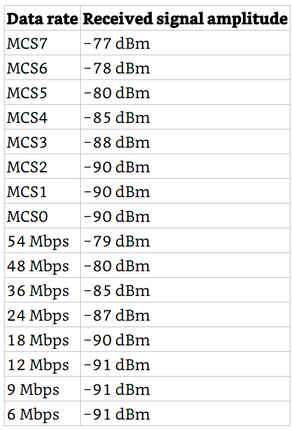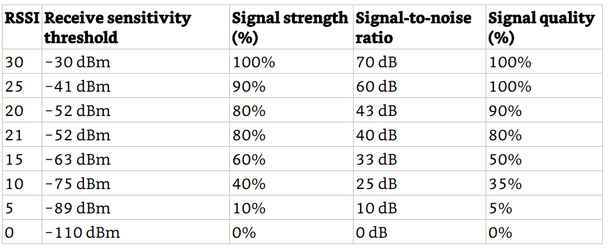RSSI
. . . .
RSSI (Received Signal Strength Indicator)
- Receive sensitivity refers to the power level of an RF signal required to be successfully received by the receiver radio.
- The lower the power level that the receiver can successfully process, the better the receive sensitivity. It is the weakest signal that the transceiver can decode under normal circumstances.
- Received signal strength indicator (RSSI) is a relative metric used by 802.11 radios to measure signal strength (amplitude).
- The 802.11 RSSI measurement parameter can have a value from 0 to 255.
- The RSSI value is designed to be used by the WLAN hardware manufacturer as a relative measurement of the RF signal strength that is received by an 802.11 radio.
- Wi-Fi vendors will usually specify their receive sensitivity thresholds at various data rates; an example vendor specification for a 2.4 GHz radio is listed in Table 3.3.
- The RSSI value is designed to be used by the WLAN hardware manufacturer as a relative measurement of the RF signal strength that is received by an 802.11 radio.
- RSSI metrics are typically mapped to receive sensitivity thresholds expressed in absolute dBm values, as shown in Table 3.4.
For example, an RSSI metric of 30 might represent –30 dBm of received signal amplitude. The RSSI metric of 0 might be mapped to –110 dBm of received signal amplitude. Another vendor might use an RSSI metric of 255 to represent –30 dBm of received signal amplitude and 0 to represent –100 dBm of received signal amplitude.
The 802.11-2012 standard also defines another metric called signal quality (SQ), the signal quality could be a measurement of what might affect coding techniques, such as the Barker code or Complementary Code Keying (CCK), which relates to the transmission speed. Some SQ parameters might also be used in conjunction with RSSI as part of a clear channel assessment (CCA) scheme.
Although SQ metrics and RSSI metrics are technically separate measurements, most Wi-Fi vendors refer to both together as simply RSSI metrics.
Because the implementation of RSSI metrics is proprietary, two problems exist when trying to compare RSSI values between different manufacturers’ wireless cards. The first problem is that the manufacturers may have chosen two different values as the RSSI_Max. So WLAN vendor A may have chosen a scale from 0 to 100, whereas WLAN vendor B may have chosen a scale from 0 to 30. Because of the difference in scale, WLAN vendor A may indicate a signal with an RSSI value of 25, whereas vendor B may indicate that same signal with a different RSSI value of 8.
Although the way in which Wi-Fi vendors implement RSSI may be proprietary, most vendors are alike in that they use RSSI thresholds for very important mechanisms, such as roaming and dynamic rate switching. During the roaming process, clients make the decision to move from one access point to the next. RSSI thresholds are key factors for clients when they initiate the roaming handoff.
RSSI thresholds are also used by vendors to implement dynamic rate switching (DRS), which is a process used by 802.11 radios to shift between data rates.
The 802.11-2012 standard also defines another metric called signal quality (SQ), the signal quality could be a measurement of what might affect coding techniques, such as the Barker code or Complementary Code Keying (CCK), which relates to the transmission speed. Some SQ parameters might also be used in conjunction with RSSI as part of a clear channel assessment (CCA) scheme.
Although SQ metrics and RSSI metrics are technically separate measurements, most Wi-Fi vendors refer to both together as simply RSSI metrics.
Because the implementation of RSSI metrics is proprietary, two problems exist when trying to compare RSSI values between different manufacturers’ wireless cards. The first problem is that the manufacturers may have chosen two different values as the RSSI_Max. So WLAN vendor A may have chosen a scale from 0 to 100, whereas WLAN vendor B may have chosen a scale from 0 to 30. Because of the difference in scale, WLAN vendor A may indicate a signal with an RSSI value of 25, whereas vendor B may indicate that same signal with a different RSSI value of 8.
Although the way in which Wi-Fi vendors implement RSSI may be proprietary, most vendors are alike in that they use RSSI thresholds for very important mechanisms, such as roaming and dynamic rate switching. During the roaming process, clients make the decision to move from one access point to the next. RSSI thresholds are key factors for clients when they initiate the roaming handoff.
RSSI thresholds are also used by vendors to implement dynamic rate switching (DRS), which is a process used by 802.11 radios to shift between data rates.
Reference:
Coleman, David D.,Westcott, David A. CWNA: Certified Wireless Network Administrator Official Study Guide: Exam CWNA-106 Wiley.
Coleman, David D.,Westcott, David A. CWNA: Certified Wireless Network Administrator Official Study Guide: Exam CWNA-106 Wiley.
|
|


